
Search
The Renewable Energy site for Do-It-Yourselfers
Full Scale Test of Evapro/Radiation
Cooling System
| These are the results from the first full scale test of the Evapro/Radiation
cooling system that I
experimented a bit with last year. The full scale version uses the
North roof surface of my
Solar Shed
as the cooling radiator to cool a 430 gallon tank of water during the
night time. When cooling is needed during the following day,
the cooled water in the tank is pumped through the radiant floor heating
loops in the house for cooling.
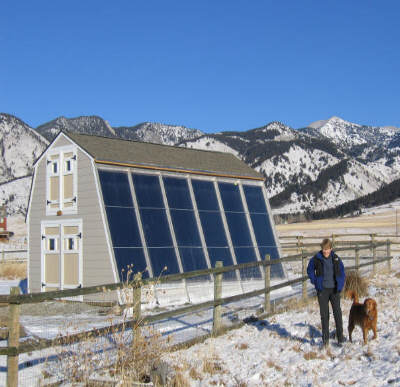
Solar Shed space heater, now used for cooling as well.
In my case, the system involves very little extra cost or work
because nearly all the components are already there for the existing
solar space heating system. |
|
This is really just a first try at a
practical system. The results are encouraging, and I plan to do further
work on it when our 10 month Montana winter ends :)
The Setup
The system uses our existing
Solar Shed solar
space heating system, which is described in detail here...
In a nutshell, the current heating
system consists of 240 sqft of solar heating collector mounted on the south face
of the Solar Shed, which heats a 430 gallon hot water storage tank. The
solar heated water is pumped over to the house via an insulated underground pipe
and circulated through PEX loops in the floor for radiant floor heating.
This system has been operating for about 5 years and provides a significant part
of our winter heating needs.
To use this same system for cooling,
the north side of the Solar Shed roof is set up as a evaporative/radiation
cooling surface. Water from the 430 gallon storage tank is pumped to the
ridge of the Solar Shed roof, and allowed to trickle down the roof surface.
The water trickling down the roof is cooled by a combination of radiation to the
cold night sky and evaporation of the water. The
evaporative/radiation cooling idea is
explained in more detail here...
The only new components added to use
the same system for cooling are:
- Added a tube along the ridge of
the Solar Shed to distribute water over the shed roof.
- Added a gutter and some
plumbing to collect the water at the lower edge of the roof and route it
back to the tank.
- A pump to pump the water to the
roof top (potentially the same pump as the solar heating collectors use)
- A timer or more sophisticated
control to turn the system on in the middle of the night for a set time.
The rest of the system including
storage tank, plumbing to house, floor heating(cooling) loops, and even the
house heating controls were used unchanged from the solar heating system.
The pictures below show the first
full scale test setup. Given that I expected to have to make changes and
refinements, I did not take a whole lot of care to make it "pretty" -- but, its
a very simple system, and a few hours more work would take care of the rough
edges.
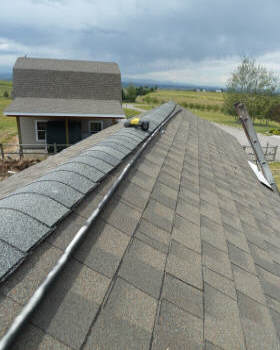
Spray bar along ridge line.
Slight slope allows for even spray. |
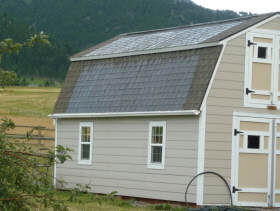
System in action spraying water over roof.
Of course, this would normally be at night. |
There was just not much hot weather
this summer, so not a lot of incentive to get this full scale test hooked up and
running. In the end, I did not get to installing the new stuff until late
August, and the testing was just one day when the temperature got up to 96F (our
only really hot day of the summer). I plan to do more with this next year,
but thought I would pass on the data for the one day we did use the system.
Part 1: Cooling the Tank Water
Using this system is a two part
process: part 1 is cooling the water in the "coolth" storage tank, and part 2 is
transferring the stored coolth to the house interior when needed.
The plot just below shows the only
night of cooling the tank with the new system results.
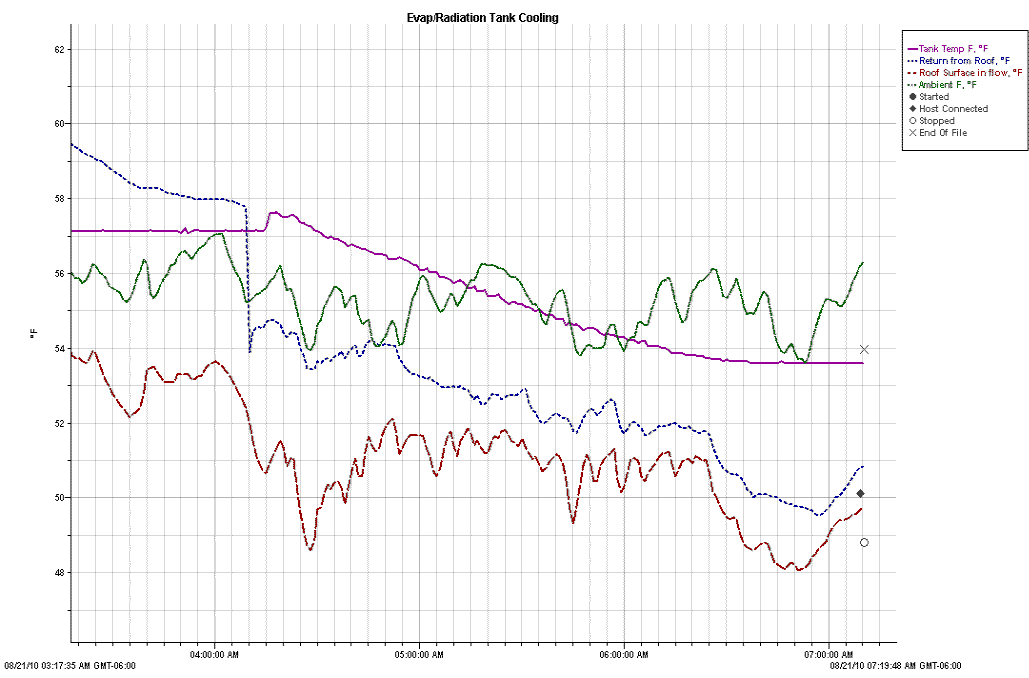
Where:
Purple line is tank temperature
(F)
Greenish line is ambient
temperature (F)
Dark blue short dash line is
water returning from roof temperature (F)
Red line (lowest) is the roof
surface temperature in an area with water flow over it (F)
The timer turns the pump on at about
4:10 am, and it runs until about 6:20 am.
In this case, the tank was cooled
from about 57.5F down to about 53.5 F. This is a pretty small
temperature drop, but bear in mind:
- If the system were in regular
use, the starting tank temp would have been in the 60's Frather than the
57.5F. This would require a little more run time, but there is plenty
of time available during the night.
- It looks like the system could
have achieved some further cooling had it not been turned off at 6:20 am.
The roof radiator was able to cool
the water about 2F below the ambient night temperature, and could probably have
achieved greater cooling 1) if it had been run longer, and 2) with some further
optimization of the radiator. This is supported by the
earlier tests in which a lower tank temperature is achieved.
The cooling rate achieved is:
Radiator area = 240 sf
Cooling achieved = (430 gal)(8.33
lb/gal) (57.5F - 53.5F) = 14300 BTU
The cooling rate per sqft of
collector, per hour of operation was:
BTU/sqft-hr = (430
gal)(8.33 lb/gal)(1.9 hr)(1 BTU/lb-F) / (240 Sqft) = 27.6 BTU pers hour per
sqft of collector.
Where 1.9 F is the average rate
of cooling of the tank water per hour of operation from the plot.
This compares with 33.8 BTU/sf-hr
achieved by the 14 sf aluminum radiator in the
previous test...
So, to a first cut, it looks like the asphalt shingle roof performs about
82% of the aluminum sheet radiator.
Some additional runs would be
needed to confirm this.
One practical design observation for
this system is that rain water that falls on the shed roof ends up in the
storage tank. This is a good news/bad news thing. The good news is
that the collected water would help offset the evaporation of water as it flows
over the roof. The bad news is that you could easily overflow the tank in
a good rainstorm. So, for a practical design, the tank has to have an
overflow outlet that will run excess water off into the weeds, or you will end
up with a mess.
I suppose that an enterprising
person could use this scheme to combine a large rainwater catchment system with
a house cooling system.
The only control I used to turn the
water on to the roof spray bar was a simple 24 hour timer set to come on for a
couple hours before dawn. For around here that might work fine with
just an manual override to keep the system from turning on if the tank is
already cold enough. Fancier controls that run the system long enough to
cool to a lower set point might also be used.
Part 2: Cooling the house
The 2nd part of the system is making
use of the coolth stored in the tank to meet the cooling needs of the house
during the day.
We were only able to test this on the
96 F day mentioned above -- these are the results from this one day test.
Since we ventilated the night before and morning of the predicted 96F day, no
cooling was needed until early afternoon.
| |
Radiant floor loops |
Main floor |
|
|
Outside |
|
|
Time |
Floor In(F) |
Floor Out(F) |
Tfloor1 |
Tfloor2 |
Tfloor3 |
TroomAir |
Tambient |
|
|
1:49 PM |
51 F |
61 F |
76 F |
77 F |
74 F |
76 F |
90 F |
System turned on |
|
2:10 PM |
52 |
60 |
74.6 |
76 |
74.1 |
74 |
92 |
|
|
2:30 PM |
52 |
60 |
73 |
73.4 |
73 |
75.5 |
92 |
|
|
4:50 PM |
56 |
60 |
74.6 |
73.7 |
76.6 |
76 |
93 |
|
|
6:00 PM |
58 |
62 |
74.6 |
74.4 |
77 |
77 |
91 |
|
|
8:00 PM |
60 |
63 |
77.1 |
75 |
79.1 |
76 |
79 |
system turned off |
Where:
- Floor In is the temperature of
the water from the tank as it enters the radiant floor loops.
- Floor Out is the temperature of
the water leaving the radiant floor loops
- Tfloor1 through Tfloor3 are the
temps of 3 places on the main floor where floor loops are installed --
measured with an IR temperature gun.
- TroomAir is the room
temperature of the main floor living area measured 4 ft above the floor.
- Tambient is the outside ambient
temperature.
I did not record relative humidity,
but this is a dry area, and typically has low humidity.
So, during the time the system was
on, the tank water was warmed from 51F up to 60F. This corresponds to:
Coolth Delivered = (430gal)(8.33
lb/gal)(60F - 51F)(1 BTU/lb-F) = 32,237 BTU of cooling.
This is roughly equivalent to a
half ton AC running 6 hours.
If you look at the room air temps,
the system was able to keep comfortable temps in the house throughout the
afternoon and evening until the outside air cooled enough to not need any more
cooling. Maximum room temp at 6pm was 77F.
The floor temps (in areas cooled by
the radiant floor loops) were in the 73F up to 77 F area
Observations:
- As the tank water warms, it is
delivering less coolth to the room. When the tank is at 51F, the
temp rise over the floor loops is 10F, but when the tank is up to 60F, the
temp rise is reduced to 3F, so about 1/3rd the cooling by the end of the
day.
I guess that a couple message are
that 1) getting the tank temp as low as possible is good, and 2) a larger
tank may be necessary for higher cooling loads than we have.
On the other hand, this was
easily the hottest day of the year here, and the system met our full cooling
need.
- The system does not lower
humidity at all, so areas with both high temps and high humidity would need
some additional means to reduce humidity.
Another interesting thing was that
the same controls that control the radiant floor heating in the winter for the
solar heating system also work with the cooling system. There
are two thermostats that are hooked in series -- one that senses storage tank
temperature and the other room temperature. In the winter they the tank
thermostat is in "cooling mode", and turns on when the tank is hot enough to
provide heat. The room thermostat is in "heating mode", and turns on when
the room is cool enough to need heat.
For the cooling system, the tank
thermostat is switched to "heating mode", and the room thermostat is switched to
"cooling mode", and it works with no further changes except to reset the
temperature set points -- almost like it was planned that way.
Efficiency
A very rough go at energy efficiency
of this cooling system:
I use a Taco 008 pump to deliver
flow to the winter solar heating collectors. This pump uses 90
watts.
Since it would be desirable to
use the same pump summer and winter, and its about the right size for the
summer circulation to the roof radiator, I will use its power consumption
for the power use during cooling. With this arrangement,
resetting a couple valves to change the plumbing around would be all that is
involved in a winter to summer switch over.
Lets target cooling the 430
gallons (3580 lbs) from about 61F down to 49F for a total cooling of
(12F)(3580 lb)(1 BTU/lb-F) = 43,000 BTU.
43K BTU is about equivalent to a half ton AC run for 7 hours -- fine
for my house even on very hot days.
Based on the test above that
achieved 28 BTU per sqft of radiator per hour of cooling, and using the same
240 sf of north roof radiator area, the run time to cool the tank the full
12 F would be:
43,000 BTU = (28 BTU/sf-hr)(240
sf) (Trun hrs)
Trun = (43000
BTU)/((240sf)(28 BTU/sf-hr) ) = 6.4 hours of run time for 43K of
cooling.
Pump energy consumed is then (90
watts)(6.4 hr) = 576 watt-hr, or 1965 BTU
COP = (energy out) / (energy in)
= (43,000 BTU) / (1,965 BTU) = 21.9 (or a rough SEER of 75)
This does not include the energy
required to distribute the heat to the house on the following day -- this
might add another 300 or so watt-hours and cut the COP correspondingly.
I'm not sure exactly how the COP/SEER is figured on conventional AC units --
I do know that for heat pumps and furnaces, the energy for distribution of
heat/coolth is not normally included in the calculation.
So, this seems like pretty
impressive efficiency? Or, am I missing something?
Bottom Line, and Next Summer Tests
The water tank nighttime cooling
rates achieved by the 240 sqft asphalt roof cooling radiator are somewhat less
than the earlier test of the small metal radiator, but still probably
acceptable. For next summer I plan to:
- Do some more tests of the small
metal radiator to confirm its higher efficiency, and get a better idea how
it performs under different conditions.
And, determine how much below ambient it is capable of cooling.
- Do some more tests on the 240
sf asphalt shingle radiator on the north solar shed roof. Determine
how much additional cooling longer run times will achieve, and how fart
below ambient it can cool compared to the metal collector.
- Decide on whether the metal
radiator performance is enough better to be worth doing a larger metal
radiator on the Solar Shed roof (probably just the lower part of the roof).
- Hook up the plumbing such that
the same pump that is used for winter circulation of water to the collectors
can be used as summer circulation to the radiator.
Any ideas would be appreciated.
Reports on any similar systems would
also be appreciated.
The house cooling part of the test
that used the existing radiant floor system to distribute coolth to the house
seemed to work fine, and I'll probably just use it in the same way as we did for
the first test.
I may also just have a go at using
well water for cooling with the water first used for cooling, and then
irrigation.
For those interested in more reading
on innovative cooling systems by Steve Baer and the FSEC:
Gary September 6, 2010





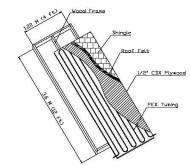 tegrated with the roof structure and a unique
thermal storage system to provide solar thermal heating in the winter and
radiation cooling in the summer. Amazing!
tegrated with the roof structure and a unique
thermal storage system to provide solar thermal heating in the winter and
radiation cooling in the summer. Amazing!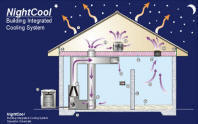 This
is a simple, building integrated, cooling scheme that uses nighttime
radiation cooling from a metal roof to cool air in the attic space.
Attic air is then circulated into the living area to provide cooling.
This
is a simple, building integrated, cooling scheme that uses nighttime
radiation cooling from a metal roof to cool air in the attic space.
Attic air is then circulated into the living area to provide cooling.